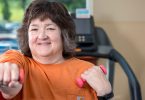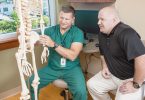Updated September 23, 2019.
Concussion diagnoses for children and young adults under age 22 increased 500 percent between 2010 to 2014, according to FAIR Health, an independent nonprofit healthcare information agency. In truth, this statistic is welcome news because it doesn’t indicate an increase in concussions per se, but rather an increase in properly diagnosed concussions that were once brushed off. “We used to refer to head injuries as ‘getting your bell rung’ and the treatment was ‘walking it off.’ We know better now. The tide is turning,” explains Stanley Hunter, MD, sports medicine specialist at the UHS Concussion Center.
To help the cause, Dr. Hunter spoke about concussion symptoms parents and children should know about on National Concussion Awareness Day 2019. Watch it here:
Riding the wave of change, the center is one of the area’s first to offer a centralized, multidisciplinary approach to the diagnosis and treatment of concussions and other mild traumatic brain injuries.
Here are three myths that the UHS Concussion Center is dedicated to reversing:
MYTH: Concussions have immediate symptoms.
A concussion is a type of traumatic brain injury that occurs when the head sustains a direct or indirect blow, often caused by a fall, accident or sporting/recreational activity.
Symptoms can appear immediately, such as a mild headache, dizziness, light sensitivity, and in extreme cases, loss of consciousness. Symptoms can also be delayed and appear unconnected to brain injury, including vomiting, mood swings, fatigue, poor coordination, unsteady balance and cognitive deficits.
Because of concussions’ unpredictable nature, Dr. Hunter emphasizes that the UHS Concussion Center considers all head injuries serious until properly evaluated.
MYTH: After a blow to the head, it’s okay to rejoin activities once symptoms subside.
Immediate symptoms cannot indicate the extent of concussion damage, which makes an evaluation by a sports medicine specialist the safest way to diagnose a concussion. To meet this need, the UHS Concussion Center maintains an integrated team of experts, including two sports medicine physicians, an urgent care physician and two orthopedic surgeons. In addition, about 20 UHS Concussion Center athletic trainers attend practices and events at nine Greater Binghamton high schools, Binghamton University and SUNY Broome.
“Athletic trainers are our eyes and ears on the ground,” Dr. Hunter says. “They have direct access to UHS sports medicine physicians — to ask questions or fast-track someone into our clinic.”
On the sidelines and in the clinic, evaluations begin with the Sport Concussion Assessment Tool (SCAT), which measures symptoms, orientation, memory, recall, balance and gait. To rule out additional injuries, clinic evaluations may also include neurological and physical therapy exams, and cognitive and imaging tests.
MYTH: Following a blow to the head, a reasonable treatment is to “walk it off.”
“The central hallmark for concussion treatment is rest until further evaluation shows that an individual is symptom-free,” Dr. Hunter says. He recommends gradually increasing activity levels. “As we expand activity levels, we re-evaluate symptoms and SCAT scores,” he adds.
FACT: Knowledge is power.
The UHS Concussion Center is dedicated to educating coaches, parents, individuals and spectators about concussions. “Everyone needs to recognize that we cannot just brush aside a concussion,” Dr. Hunter says. “Educating the public gives us an opportunity to make a big difference in every child and adult’s safety.”







